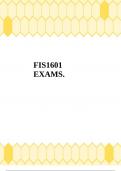FIS1601
EXAMS.
, This document contains previous exam questions & answers ranging from 2015 - 2019
Answers were taken from the Prescribed Book.
Please note that human errors are possible in this document
TABLE OF CONTENT
May/June 2015 Page 3
October/November 2015 Page 21
May/June 2016 Page 37
October/November 2016 Page 55
May/June 2017 Page 75
October/November 2017 Page 90
May/June 2018 Page 104
May/June 2019 Page 114
, MAY/JUNE 2015
QUESTION 1
1. Write brief notes on five of the body’s organ systems.
Skeletal System
The skeletal system consists of bones, cartilages and joints.It supports the body and provides a framework that
the skeletal muscles use to cause movement. It also has protective functions (for example, the skull encloses
and protects the brain), and the cavities of the skeleton are the sites where blood cells are formed. The hard
substance of bones acts as a storehouse for minerals.
Cardiovascular System
The primary organs of the cardiovascular system are the heart and blood vessels.Using blood as a carrier, the
cardiovascular system delivers oxygen, nutrients, hormones, and other substances to, and picks up wastes such
as carbon dioxide from, cells near sites of exchange. White blood cells and chemicals in the blood help to
protect the body from such foreign invaders as bacteria, viruses, and tumor cells. The heart propels blood out of
its chambers into blood vessels to be transported to all body tissues.
Muscular System
The muscles of the body have only one function to contract, or shorten. When this happens, movement
occurs. The mobility of the body as a whole reflects the activity of skeletal muscles, the large, fleshy muscles
attached to bones.When these contract, you are able to stand erect,walk, jump, grasp, throw a ball, or smile.
The skeletal muscles form the muscular system. These muscles are distinct from the muscles of the heart and of
other hollow organs, which move fluids (such as blood or urine) or other substances (such as food) along
definite pathways within the body.
Nervous System
The nervous system is the body’s fast-acting control system. It consists of the brain, spinal cord, nerves, and
sensory receptors.The body must be able to respond to stimuli coming from outside the body (such as light,
sound, or changes in temperature) and from inside the body (such as decreases in oxygen or stretching of
tissue). The sensory receptors detect changes in temperature, pressure, or light, and send messages (via
electrical signals called nerve impulses) to the central nervous system (brain and spinal cord) so that it is
constantly informed about what is going on. The central nervous system then assesses this information and
responds by activating the appropriate body effectors (muscles or glands, which are organs that produce
secretions).
Respiratory System
The job of the respiratory system is to keep the body supplied with oxygen and to remove carbon dioxide. The
respiratory system consists of the nasal passages, pharynx, larynx, trachea, bronchi, and lungs.Within the lungs
are tiny air sacs. Gases are exchanged with the blood through the thin walls of these air sacs.
, 2. Briefly discuss human survival needs
The goal of nearly all body systems is to maintain life.However, life is extraordinarily fragile and requires that
several factors be available. These factors, which we will call survival needs, include nutrients (food), oxygen,
water, and appropriate temperature and atmospheric pressure.
Nutrients, which the body takes in through food, contain the chemicals used for energy and cell building.
Carbohydrates are the major energy providing fuel for body cells. Proteins and, to a lesser extent, fats are essential
for building cell structures. Fats also cushion body organs and provide reserve fuel. Minerals and vitamins are
required for the chemical reactions that go on in cells and for oxygen transport in the blood.
All the nutrients in the world are useless unless oxygen is also available. Because the chemical reactions that
release energy from foods require oxygen, human cells can survive for only a few minutes without it. It is made
available to the blood and body cells by the cooperative efforts of the respiratory and cardiovascular systems.
Water accounts for 60 to 80 percent of body weight, depending on the age of the individual. It is the single most
abundant chemical substance in the body and provides the fluid base for body secretions and excretions. We obtain
water chiefly from ingested foods or liquids, and we lose it by evaporation from the lungs and skin and in body
excretions.
If chemical reactions are to continue at life sustaining levels, normal body temperature must be maintained. If
body temperature drops below 37°C (98.6°F), metabolic reactions become slower and slower and finally stop. If
body temperature is too high, chemical reactions proceed too rapidly, and body proteins begin to break down. At
either extreme, death occurs. Most body heat is generated by the activity of the skeletal muscles and dissipated via
blood circulating close to the skin surface or by the evaporation of sweat.
The force exerted on the surface of the body by the weight of air is referred to as atmospheric pressure. Breathing
and the exchange of oxygen and carbon dioxide in the lungs depend on appropriate atmospheric pressure. At high
altitudes, where the air is thin and atmospheric pressure is lower, gas exchange may be too slow to support cellular
metabolism.
The mere presence of these survival factors is not sufficient to maintain life.They must be present in appropriate
amounts as well;excesses and deficits may be equally harmful.For example,the food ingested must be of high
quality and in proper amounts; otherwise, nutritional disease, obesity, or starvation is likely.




